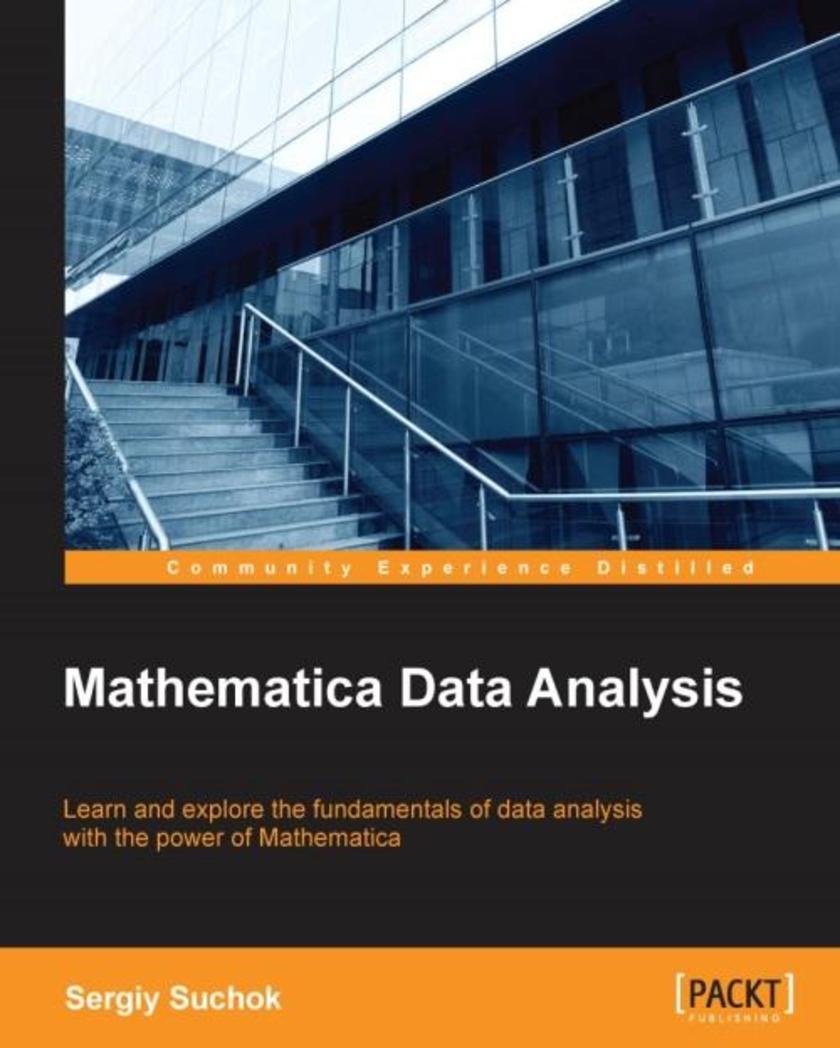
Mathematica Data Analysis
¥63.21
Learn and explore the fundamentals of data analysis with power of Mathematica About This Book Use the power of Mathematica to analyze data in your applications Discover the capabilities of data classification and pattern recognition offered by Mathematica Use hundreds of algorithms for time series analysis to predict the future Who This Book Is For The book is for those who want to learn to use the power of Mathematica to analyze and process data. Perhaps you are already familiar with data analysis but have never used Mathematica, or you know Mathematica but you are new to data analysis. With the help of this book, you will be able to quickly catch up on the key points for a successful start. What You Will Learn Import data from different sources to Mathematica Link external libraries with programs written in Mathematica Classify data and partition them into clusters Recognize faces, objects, text, and barcodes Use Mathematica functions for time series analysis Use algorithms for statistical data processing Predict the result based on the observations In Detail There are many algorithms for data analysis and it’s not always possible to quickly choose the best one for each case. Implementation of the algorithms takes a lot of time. With the help of Mathematica, you can quickly get a result from the use of a particular method, because this system contains almost all the known algorithms for data analysis. If you are not a programmer but you need to analyze data, this book will show you the capabilities of Mathematica when just few strings of intelligible code help to solve huge tasks from statistical issues to pattern recognition. If you're a programmer, with the help of this book, you will learn how to use the library of algorithms implemented in Mathematica in your programs, as well as how to write algorithm testing procedure. With each chapter, you'll be more immersed in the special world of Mathematica. Along with intuitive queries for data processing, we will highlight the nuances and features of this system, allowing you to build effective analysis systems. With the help of this book, you will learn how to optimize the computations by combining your libraries with the Mathematica kernel. Style and approach This book takes a step-by-step approach, accompanied by examples, so you get a better understanding of the logic of writing algorithms for data analysis in Mathematica. We provide a detailed explanation of all the nuances of the Mathematica language, no matter what your level of experience is.
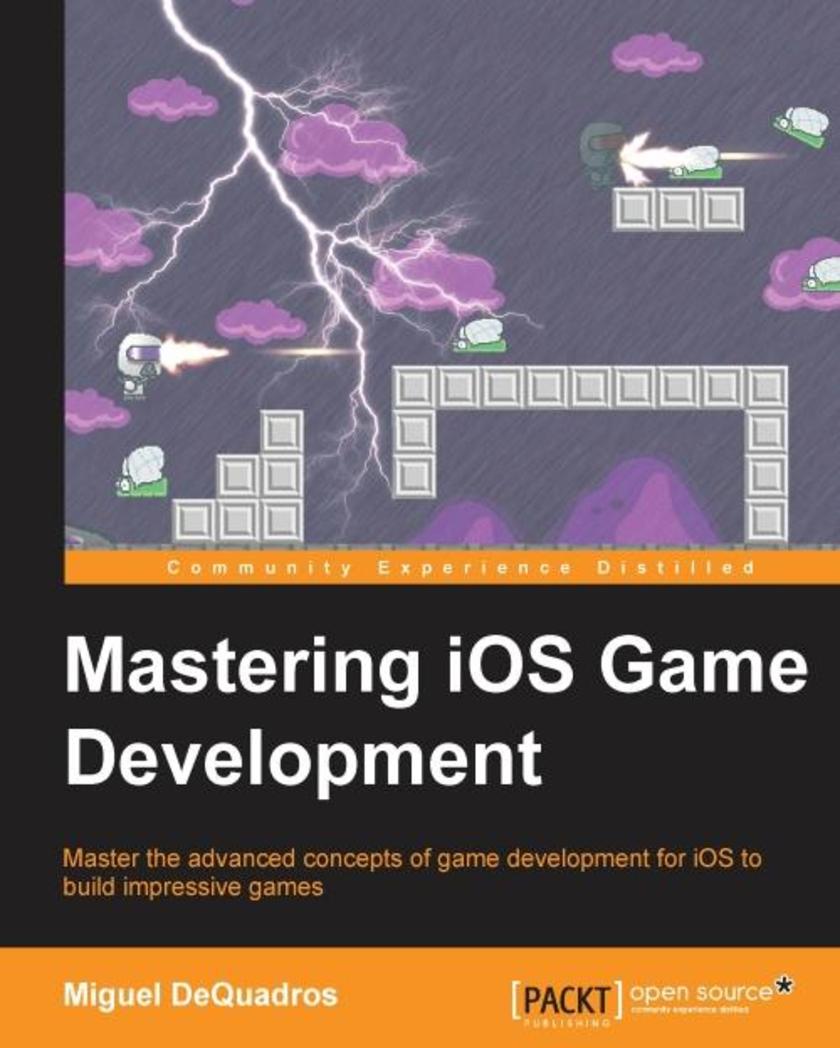
Mastering iOS Game Development
¥80.65
Master the advanced concepts of game development for iOS to build impressive games About This Book Create a complete game with advanced techniques through the course of the book using in-depth, hands-on instructions Learn how to multi-task and improve performance optimization in your game playing experience The author, Miguel, has 11 years of iOS game development using xcode and has released over 10 games to the Apple AppStoreMaster player movement using touch controls as well as discuss motion controls Who This Book Is For This book is for those who have created an iOS game already and want to hone their skills. A reasonable level of knowledge and an understanding of the core elements and applications would be helpful. What You Will Learn Blast off and start developing fun games Optimize the assets for the best performance in the game app Master player movement using touch controls as well as discuss motion controls Perform bug Squashing by testing and debugging Design interesting various characters and enemies for your game Test your game on both, the simulator on the computer and on real devices Tweak and fine tune the code and graphics before the release of your app Uncover some awesome new gameplay by adding in multiplayer elements, to get more people playing together In Detail iOS is an operating system for Apple manufactured phones and tablets. Mobile gaming is one of the fastest-growing industries, and compatibility with iOS is now becoming the norm for game developers. SpriteKit is part of the native SDK from Apple, and enables developers to make simple entry into game development without unnecessary overhead and a long learning process. SpriteKit also provides other functionality that is useful for games, including basic sound playback support and physics simulation. In addition, Xcode provides built-in support for SpriteKit so that you can create complex special effects and texture atlases directly in Xcode. This combination of framework and tools makes SpriteKit a good choice for games and other apps that require similar kinds of animation. Become a master in iOS game development through this fast and fun guide! In the beginning, we’ll tell you everything you need to plan and design your game. You’ll then start developing your game through step-by-step instructions using the various built-in technologies of Xcode. From there on, we discuss how to deploy your game to the iOS App Store, as well as monetizing it to make more revenue. You will also learn advanced techniques to improve your game playing experience, including better multi-tasking, improved performance optimization, battery management, and more. To end the book off, we’ll show you how to update your game with different features, then port the update to the App Store. Style and approach This book provides an easy-to-understand and fun approach to game development, with step-by-step instructions and detailed explanation of each block of code. The topics covered range from easy to advanced, so buckle up for a fast-paced ride!
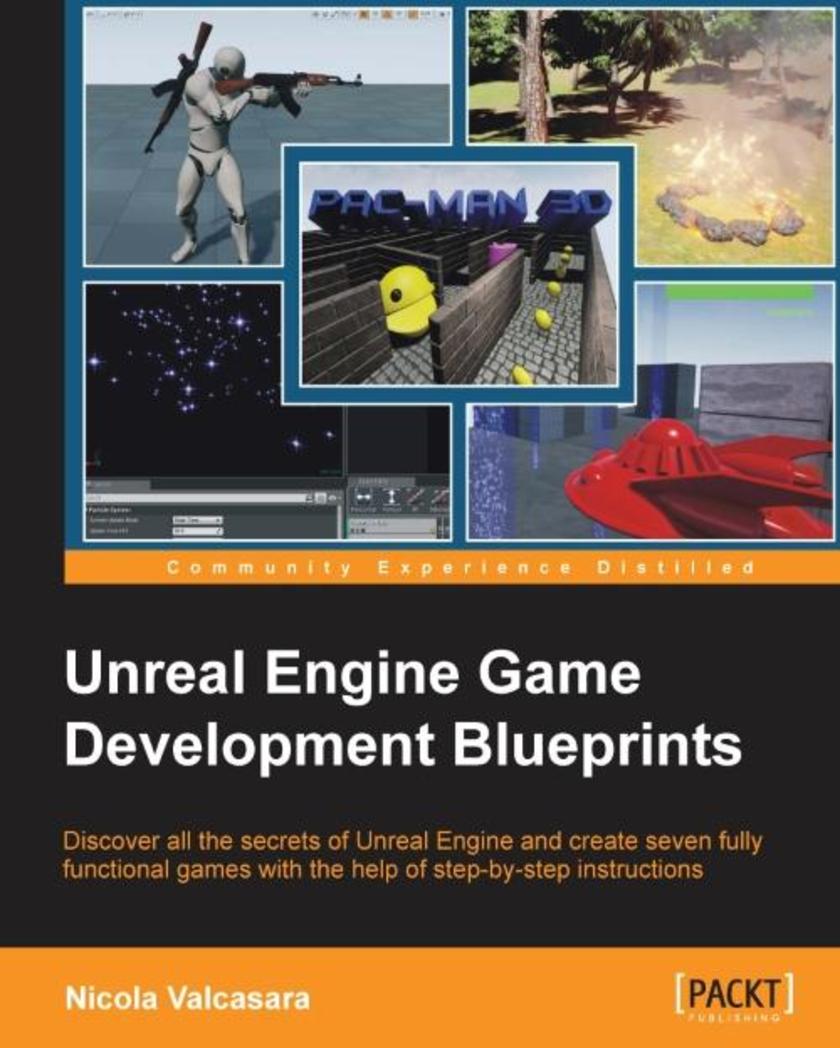
Unreal Engine Game Development Blueprints
¥90.46
Discover all the secrets of Unreal Engine and create seven fully functional games with the help of step-by-step instructions About This Book Understand what a Blueprint is and how to create a complex visual *ing code Discover the infinite possibilities that Unreal Engine offers, and understand which tool to use, where and when Learn to think like a real game developer in order to create enjoyable and bug-free games using this comprehensive and practical handbook Who This Book Is For This book is ideal for intermediate level developers who know how to use Unreal Engine and want to go through a series of projects that will further their expertise. Working knowledge of C++ is a must. What You Will Learn Write clean and reusable Blueprint *s Develop any kind of game you have in mind, following the rules used by experts Move through Unreal Engine 4, always knowing what you are doing and where to find the right tool for your needs Integrate C++ code into your projects using Visual Studio and the tools that Unreal provides Extricate between classes, nodes, interfaces, macros, and functions Work with different types of assets, from 3D objects to audio sources, from UI buttons to animations Explore all the aspects of the game logic—collisions, navigation meshes, matinees, volumes, events, and states In Detail With the arrival of Unreal Engine 4, a new wonderful tool was born: Blueprint. This visual *ing tool allows even non-programmers to develop the logic for their games, allowing almost anyone to create entire games without the need to write a single line of code. The range of features you can access with Blueprint * is pretty extensive, making it one of the foremost choices for many game developers. Unreal Engine Game Development Blueprints helps you unleash the real power of Unreal by helping you to create engaging and spectacular games. It will explain all the aspects of developing a game, focusing on visual *ing, and giving you all the information you need to create your own games. We start with an introductory chapter to help you move fluidly inside the Blueprint user interface, recognize its different components, and understand any already written Blueprint *. Following this, you will learn how to modify generated Blueprint classes to produce a single player tic-tac-toe game and personalize it. Next, you will learn how to create simple user interfaces, and how to extend Blueprints through code. This will help you make an informed decision between choosing Blueprint or code. You will then see the real power of Unreal unleashed as you create a beautiful scene with moving, AI controlled objects, particles, and lights. Then, you will learn how to create AI using a behavior tree and a global level Blueprint, how to modify the camera, and how to shoot custom bullets. Finally, you will create a complex game using Blueprintable components complete with a menu, power-up, dangerous objects, and different weapons. Style and approach This is an easy-to-follow guide full of practical game examples. Each chapter contains step-by-step instructions to build a complete game and each game uses a different tool in order to cover all the topics in a detailed and progressive manner.

Mastering MeteorJS Application Development
¥80.65
MeteorJS makes full-stack JavaScript Application Development simple – Learn how to build better modern web apps with MeteorJS, and become an expert in the innovative JavaScript framework About This Book Get your dream project up and running by building exceptional MeteorJS applications in a matter of days Learn how to integrate other JavaScript frameworks into your MeteorJS project and become an expert in full-stack development Go beyond coding and learn how to make modern design decisions – from mobile design to SEO – that drive great user experiences Who This Book Is For If you’ve already had some experience with MeteorJS but want to learn how to build even better modern web application, this book has been created for you. It provides you with a comprehensive look at one of those most important frameworks being used for the modern web today.What You Will Learn Get to grips with the basics and learn how to build a complete real-time application with MeteorJS Find out how Meteor makes full-stack development simple – become a better developer, fast. Use some of the most effective testing tools in modern web development to troubleshoot, debug and optimize your app Find out how to write custom packages for applications – so you can build your project exactly how you want Integrate React and Angular into your project Design and develop high quality animations that will give your UI the edge Build MeteorJS to serve as REST-based application and reactive system Learn how to host a MeteorJS application and then scale it for data Find out how MeteorJS can help you build for mobile Learn how to make sure you implement an effective SEO strategy in your MeteorJS application In Detail The web is dead – applications now rule our online experiences. But how are you going to build themWell, if you’ve been paying attention, you might already have tried your hand with MeteorJS, the JavaScript framework that helps you build complete full-stack web applications that are responsive and fast with ease. Mastering MeteorJS Application Development shows you how to do even more with MeteorJS – if you’re ready to try a comprehensive course through one of the most exciting frameworks in web development today, this is the book you need. Designed to take you through the entire process of building an advanced multipage application with Meteor, you’ll be able to bring your web development ideas with surprising ease. You’ll not only learn how Meteor makes web development easier, but also how you can make using Meteor easier, by automating and simplifying tasks so you can be confident you have full control of everything in your workflow – especially everything that could go wrong. From automated testing to integrating other useful frameworks such as Angular and D3, each chapter covers a crucial element in the Meteor development process. Discover how to integrate animations using Meteor’s Blaze, to give your UI designs the edge, and explore reactive programming to effectively harness RESTful systems in your projects. You will also learn how to deploy and scale your application, two crucial aspects of modern development and vital in a changing digital environment with users expecting a product and experience that delivers. With further insights on developing for mobile – and how Meteor can help you tackle the challenges of the trend – and details on incorporating SEO strategies into your application, this book isn’t just a code tutorial – it’s about creating a product that users love. Style and approach This book is a practical guide that teaches you different ways to create custom packages, efficient client and server code, and more using Meteor. This book is packed with perfect examples and explanations to help you understand the concepts. With the perfect mix of theory and practical experience, it will equip you to become a professional MeteorJS developer.
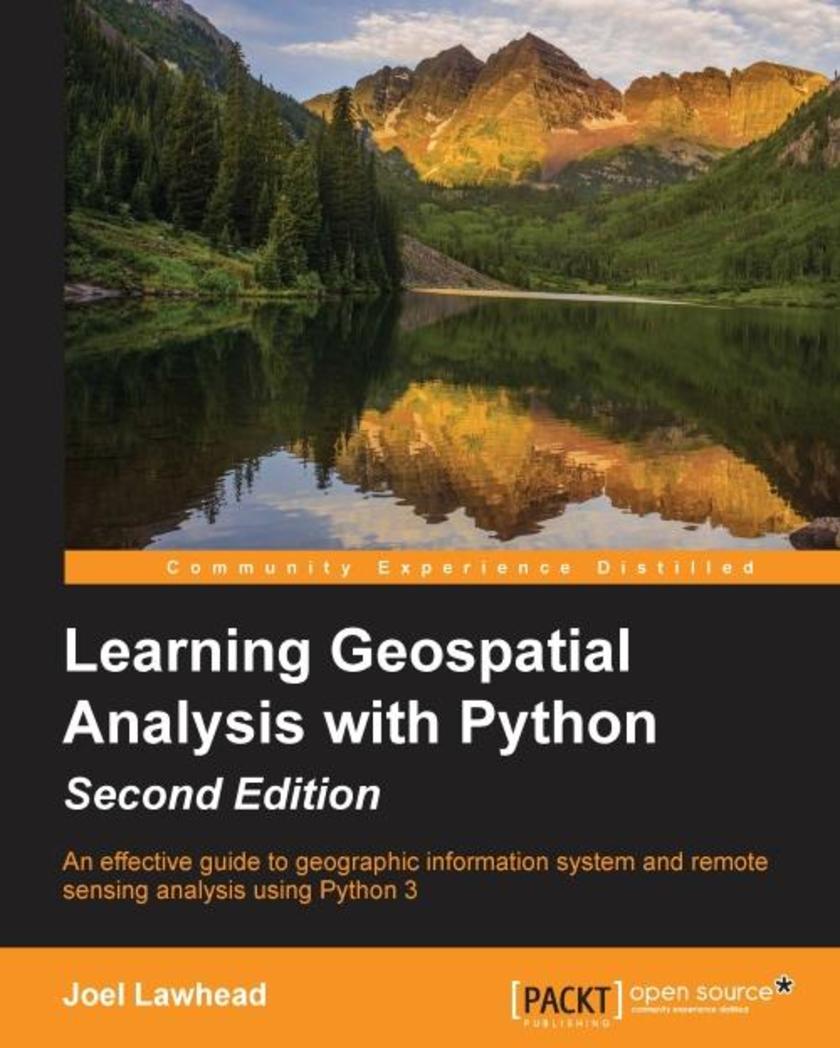
Learning Geospatial Analysis with Python - Second Edition
¥90.46
An effective guide to geographic information systems and remote sensing analysis using Python 3 About This Book Construct applications for GIS development by exploiting Python This focuses on built-in Python modules and libraries compatible with the Python Packaging Index distribution system—no compiling of C libraries necessary This practical, hands-on tutorial teaches you all about Geospatial analysis in Python Who This Book Is For If you are a Python developer, researcher, or analyst who wants to perform Geospatial, modeling, and GIS analysis with Python, then this book is for you. Familarity with digital mapping and analysis using Python or another *ing language for automation or crunching data manually is appreciated. What You Will Learn Automate Geospatial analysis workflows using Python Code the simplest possible GIS in 60 lines of Python Mold thematic maps with Python tools Get hold of the various forms that geospatial data comes in Produce elevation contours using Python tools Create flood inundation models Apply Geospatial analysis to find out about real-time data tracking and for storm chasing In Detail Geospatial Analysis is used in almost every field you can think of from medicine, to defense, to farming. This book will guide you gently into this exciting and complex field. It walks you through the building blocks of geospatial analysis and how to apply them to influence decision making using the latest Python software. Learning Geospatial Analysis with Python, 2nd Edition uses the expressive and powerful Python 3 programming language to guide you through geographic information systems, remote sensing, topography, and more, while providing a framework for you to approach geospatial analysis effectively, but on your own terms. We start by giving you a little background on the field, and a survey of the techniques and technology used. We then split the field into its component specialty areas: GIS, remote sensing, elevation data, advanced modeling, and real-time data. This book will teach you everything you need to know about, Geospatial Analysis from using a particular software package or API to using generic algorithms that can be applied. This book focuses on pure Python whenever possible to minimize compiling platform-dependent binaries, so that you don’t become bogged down in just getting ready to do analysis. This book will round out your technical library through handy recipes that will give you a good understanding of a field that supplements many a modern day human endeavors. Style and approach This is a practical, hands-on tutorial that teaches you all about Geospatial analysis interactively using Python.

OpenStack Trove Essentials
¥63.21
Build your own cloud based Database as a Service using OpenStack Trove About This Book Familiarize yourself with the concept of Database as a Service and make your existing system scalable and efficient with OpenStack Trove Minimize the administrative tasks and complexities of managing your cloud infrastructure This is a fast-paced guide to datastore management on the OpenStack platform using OpenStack Trove Who This Book Is For If you are a DBA / system administrator / architect, or a student who wants to build a Database as a Service based on OpenStack, this book is for you. You should have a basic knowledge of OpenStack components, RDBMS/NoSQL, IaaS, and cloud computing. What You Will Learn Get to grips with the basics of OpenStack and the prerequisites to install Trove Understand the expectations of DBaaS and how Trove can help you achieve them Set up a basic installation of DevStack (Development Stack) in a virtual box Install Trove and utilize its configuration groups to manage and tune databases Use Image builder to create guest images for Trove Utilize Trove to provision your first database instance Back up and restore your databases with the help of Trove In Detail OpenStack has become an extremely popular solution to build public and private clouds with. Database as a Service (DBaaS) enables the delivery of more agile database services at lower costs. Some other benefits of DBaaS are secure database deployments and compliance to standards and best practices. Trove is a DBaaS built on OpenStack and is becoming more popular by the day. Since Trove is one of the most recent projects of OpenStack, DBAs and system administrators can find it difficult to set up and run a DBaaS using OpenStack Trove. This book helps DBAs make that step. We start by introducing you to the concepts of DBaaS and how is it implemented using OpenStack Trove. Following this, we look at implementing OpenStack and deploying Trove. Moving on, you will learn to create guest images to be used with Trove. We then look at how to provision databases in self-service mode, and how to perform administration tasks such as backup and recovery, and fine-tuning databases. At the end of the book, we will examine some advanced features of Trove such as replication. Style and approach This fast-paced, step-by-step guide introduces you to DBaaS, OpenStack Trove, and its components, leading you through building your own Cloud-based DBaaS. Using the DevStack deployment method, you will spend less time on installing OpenStack so you can devote more time to learning how to provision and manage databases in a DBaaS environment.

Flask By Example
¥63.21
Unleash the full potential of the Flask web framework by creating simple yet powerful web applications About This Book The most up-to-date book on Flask on the market Create your own world-class applications and master the art of Flask by unravelling its enigma through this journey This step-by-step tutorial is packed with examples on blending different technologies with Flask to get you up and running Who This Book Is For Have you looked at PHP and hated the clunky bloated syntaxOr looked at .Net and wished it was more open and flexibleMaybe you’ve tried your hand at GUI libraries in Python and found them hard to useIf your answer to any one of these questions is a yes, then this is just the book for you. It is also intended for people who know the basics of Python and want to learn how to use it to build powerful solutions with a web front-end. What You Will Learn Build three web applications from the ground up using the powerful Python micro framework, Flask. Dynamically display data to your viewers, based on their requests Store user and static data in SQL and NoSQL databases and use this data to power your web applications Create a good user experience by combining HTML, CSS, and JavaScript Harness the convenience of freely available APIs, including OpenWeatherMap, Open Exchange Rates, and bitly Extend your applications to build advanced functionality, such as a user account control system using Flask-Login Learn about web application security and defend against common attacks, such as SQL injection and XSS In Detail This book will take you on a journey from learning about web development using Flask to building fully functional web applications. In the first major project, we develop a dynamic Headlines application that displays the latest news headlines along with up-to-date currency and weather information. In project two, we build a Crime Map application that is backed by a MySQL database, allowing users to submit information on and the location of crimes in order to plot danger zones and other crime trends within an area. In the final project, we combine Flask with more modern technologies, such as Twitter's Bootstrap and the NoSQL database MongoDB, to create a Waiter Caller application that allows restaurant patrons to easily call a waiter to their table. This pragmatic tutorial will keep you engaged as you learn the crux of Flask by working on challenging real-world applications. Style and approach This book will provide you with rich, practical experience of Flask. Every technology, that is employed along with Flask is comprehensively introduced, while the book focusses on developing web applications. Pointers to educational material are always given if you want to gain in-depth knowledge of the various technologies used.
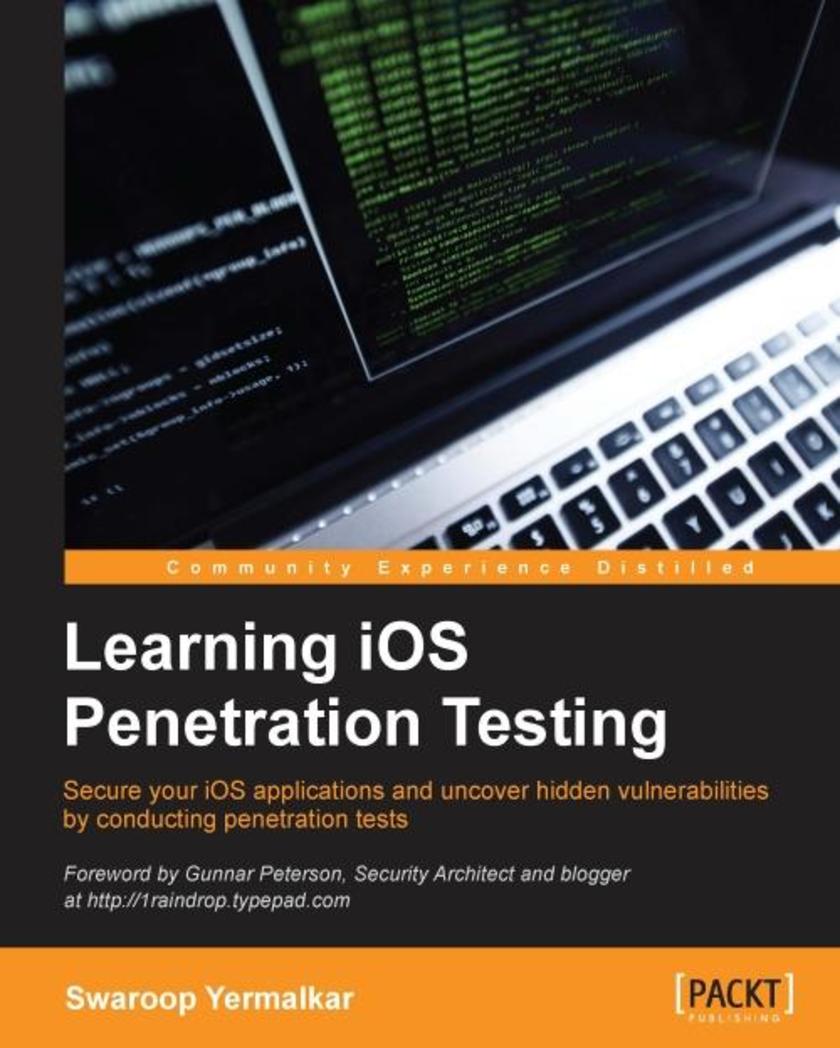
Learning iOS Penetration Testing
¥71.93
Secure your iOS applications and uncover hidden vulnerabilities by conducting penetration testsAbout This BookAchieve your goal to secure iOS devices and applications with the help of this fast paced manualFind vulnerabilities in your iOS applications and fix them with the help of this example-driven guideAcquire the key skills that will easily help you to perform iOS exploitation and forensics with greater confidence and a stronger understandingWho This Book Is ForThis book is for IT security professionals who want to conduct security testing of applications. This book will give you exposure to diverse tools to perform penetration testing. This book will also appeal to iOS developers who would like to secure their applications, as well as security professionals. It is easy to follow for anyone without experience of iOS pentesting.What You Will LearnUnderstand the basics of iOS app development, deployment, security architecture, application signing, application sandboxing, and OWASP TOP 10 for mobileSet up your lab for iOS app pentesting and identify sensitive information stored locallyPerform traffic analysis of iOS devices and catch sensitive data being leaked by side channelsModify an application’s behavior using runtime analysisAnalyze an application’s binary for security protectionAcquire the knowledge required for exploiting iOS devicesLearn the basics of iOS forensicsIn DetailiOS has become one of the most popular mobile operating systems with more than 1.4 million apps available in the iOS App Store. Some security weaknesses in any of these applications or on the system could mean that an attacker can get access to the device and retrieve sensitive information. This book will show you how to conduct a wide range of penetration tests on iOS devices to uncover vulnerabilities and strengthen the system from attacks.Learning iOS Penetration Testing discusses the common vulnerabilities and security-related shortcomings in an iOS application and operating system, and will teach you to conduct static and dynamic analysis of iOS applications.This practical guide will help you uncover vulnerabilities in iOS phones and applications. We begin with basics of iOS security and dig deep to learn about traffic analysis, code analysis, and various other techniques. Later, we discuss the various utilities, and the process of reversing and auditing.Style and approachThis fast-paced and practical guide takes a step-by-step approach to penetration testing with the goal of helping you secure your iOS devices and apps quickly.

MongoDB Cookbook - Second Edition
¥80.65
Harness the latest features of MongoDB 3 with this collection of 80 recipes – from managing cloud platforms to app development, this book is a vital resourceAbout This BookGet to grips with the latest features of MongoDB 3Interact with the MongoDB server and perform a wide range of query operations from the shellFrom administration to automation, this cookbook keeps you up to date with the world’s leading NoSQL databaseWho This Book Is ForThis book is engineered for anyone who is interested in managing data in an easy and efficient way using MongoDB. You do not need any prior knowledge of MongoDB, but it would be helpful if you have some programming experience in either Java or Python.What You Will LearnInstall, configure, and administer MongoDB sharded clusters and replica setsBegin writing applications using MongoDB in Java and Python languagesInitialize the server in three different modes with various configurationsPerform cloud deployment and introduce PaaS for MongoDiscover frameworks and products built to improve developer productivity using MongoTake an in-depth look at the Mongo programming driver APIs in Java and PythonSet up enterprise class monitoring and backups of MongoDBIn DetailMongoDB is a high-performance and feature-rich NoSQL database that forms the backbone of the systems that power many different organizations – it’s easy to see why it’s the most popular NoSQL database on the market. Packed with many features that have become essential for many different types of software professionals and incredibly easy to use, this cookbook contains many solutions to the everyday challenges of MongoDB, as well as guidance on effective techniques to extend your skills and capabilities.This book starts with how to initialize the server in three different modes with various configurations. You will then be introduced to programming language drivers in both Java and Python. A new feature in MongoDB 3 is that you can connect to a single node using Python, set to make MongoDB even more popular with anyone working with Python. You will then learn a range of further topics including advanced query operations, monitoring and backup using MMS, as well as some very useful administration recipes including SCRAM-SHA-1 Authentication. Beyond that, you will also find recipes on cloud deployment, including guidance on how to work with Docker containers alongside MongoDB, integrating the database with Hadoop, and tips for improving developer productivity.Created as both an accessible tutorial and an easy to use resource, on hand whenever you need to solve a problem, MongoDB Cookbook will help you handle everything from administration to automation with MongoDB more effectively than ever before.Style and approachEvery recipe is explained in a very simple set-by-step manner yet is extremely comprehensive.
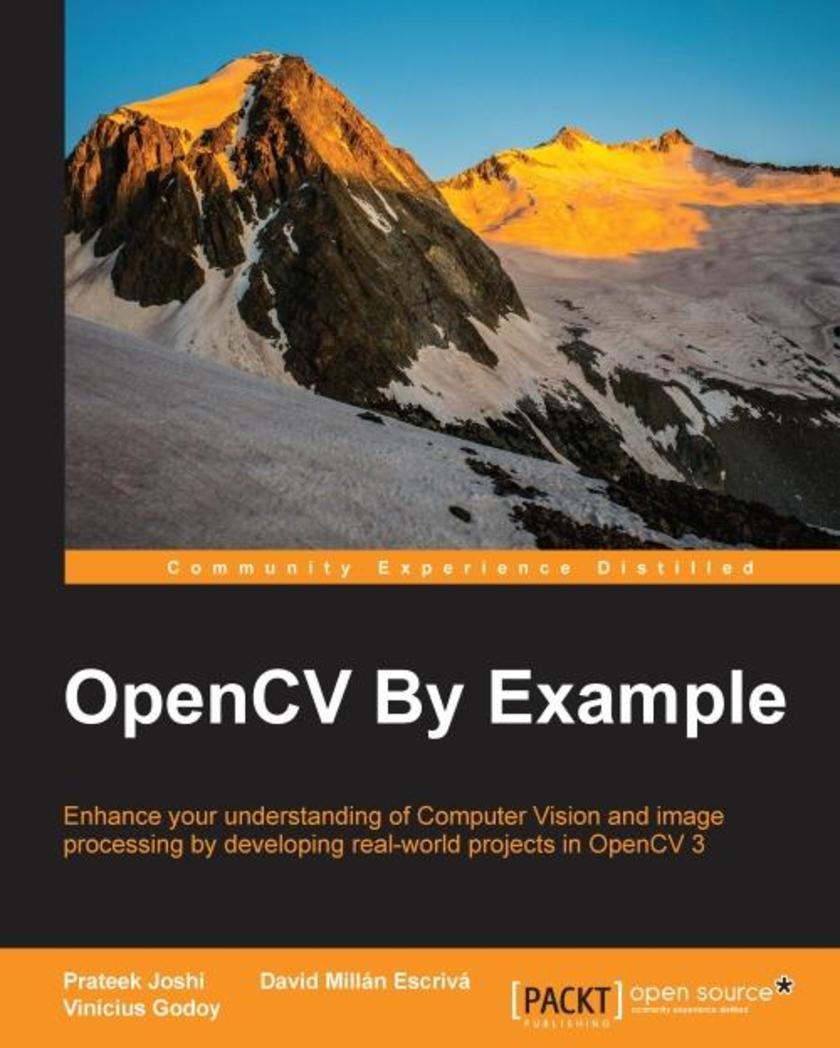
OpenCV By Example
¥90.46
Enhance your understanding of Computer Vision and image processing by developing real-world projects in OpenCV 3About This BookGet to grips with the basics of Computer Vision and image processingThis is a step-by-step guide to developing several real-world Computer Vision projects using OpenCV 3This book takes a special focus on working with Tesseract OCR, a free, open-source library to recognize text in imagesWho This Book Is ForIf you are a software developer with a basic understanding of Computer Vision and image processing and want to develop interesting Computer Vision applications with Open CV, this is the book for you. Knowledge of C++ is required.What You Will LearnInstall OpenCV 3 on your operating systemCreate the required CMake *s to compile the C++ application and manage its dependenciesGet to grips with the Computer Vision workflows and understand the basic image matrix format and filtersUnderstand the segmentation and feature extraction techniquesRemove backgrounds from a static scene to identify moving objects for video surveillanceTrack different objects in a live video using various techniquesUse the new OpenCV functions for text detection and recognition with TesseractIn DetailOpen CV is a cross-platform, free-for-use library that is primarily used for real-time Computer Vision and image processing. It is considered to be one of the best open source libraries that helps developers focus on constructing complete projects on image processing, motion detection, and image segmentation.Whether you are completely new to the concept of Computer Vision or have a basic understanding of it, this book will be your guide to understanding the basic OpenCV concepts and algorithms through amazing real-world examples and projects.Starting from the installation of OpenCV on your system and understanding the basics of image processing, we swiftly move on to creating optical flow video analysis or text recognition in complex scenes, and will take you through the commonly used Computer Vision techniques to build your own Open CV projects from scratch.By the end of this book, you will be familiar with the basics of Open CV such as matrix operations, filters, and histograms, as well as more advanced concepts such as segmentation, machine learning, complex video analysis, and text recognition.Style and approachThis book is a practical guide with lots of tips, and is closely focused on developing Computer vision applications with OpenCV. Beginning with the fundamentals, the complexity increases with each chapter. Sample applications are developed throughout the book that you can execute and use in your own projects.
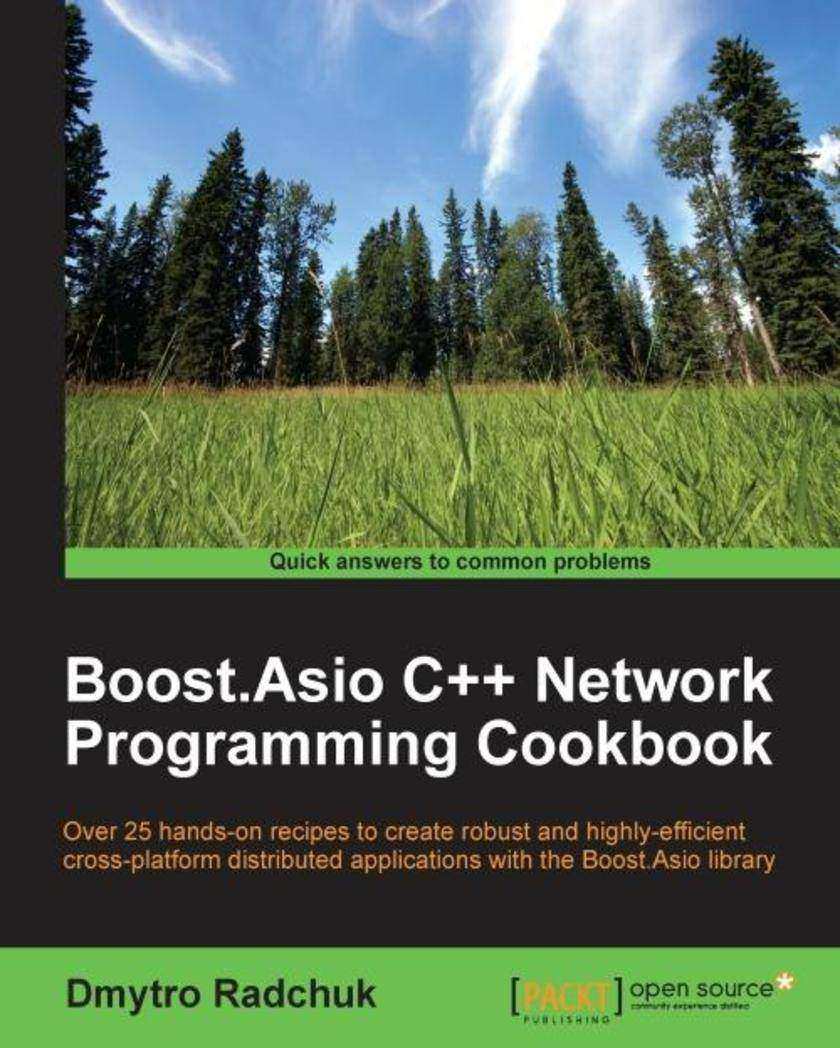
Boost.Asio C++ Network Programming Cookbook
¥90.46
Over 25 hands-on recipes to create robust and highly-efficient cross-platform distributed applications with the Boost.Asio libraryAbout This BookBuild highly efficient distributed applications with easeEnhance your cross-platform network programming skills with one of the most reputable C++ librariesFind solutions to real-world problems related to network programming with ready-to-use recipes using this detailed and practical handbookWho This Book Is ForIf you want to enhance your C++ network programming skills using the Boost.Asio library and understand the theory behind development of distributed applications, this book is just what you need. The prerequisite for this book is experience with general C++11. To get the most from the book and comprehend advanced topics, you will need some background experience in multithreading.What You Will LearnBoost your working knowledge of one of the most reputable C++ networking libraries—Boost.AsioFamiliarize yourself with the basics of TCP and UDP protocolsCreate scalable and highly-efficient client and server applicationsUnderstand the theory behind development of distributed applicationsIncrease the security of your distributed applications by adding SSL supportImplement a HTTP client easilyUse iostreams, scatter-gather buffers, and timersIn DetailStarting with recipes demonstrating the execution of basic Boost.Asio operations, the book goes on to provide ready-to-use implementations of client and server applications from simple synchronous ones to powerful multithreaded scalable solutions. Finally, you are presented with advanced topics such as implementing a chat application, implementing an HTTP client, and adding SSL support. All the samples presented in the book are ready to be used in real projects just out of the box.As well as excellent practical examples, the book also includes extended supportive theoretical material on distributed application design and construction.Style and approachThis book is a set of recipes, each containing the statement and de*ion of a particular practical problem followed by code sample providing the solution to the problem and detailed step-by-step explanation. Recipes are grouped by topic into chapters and ordered by the level of complexity from basic to advanced.
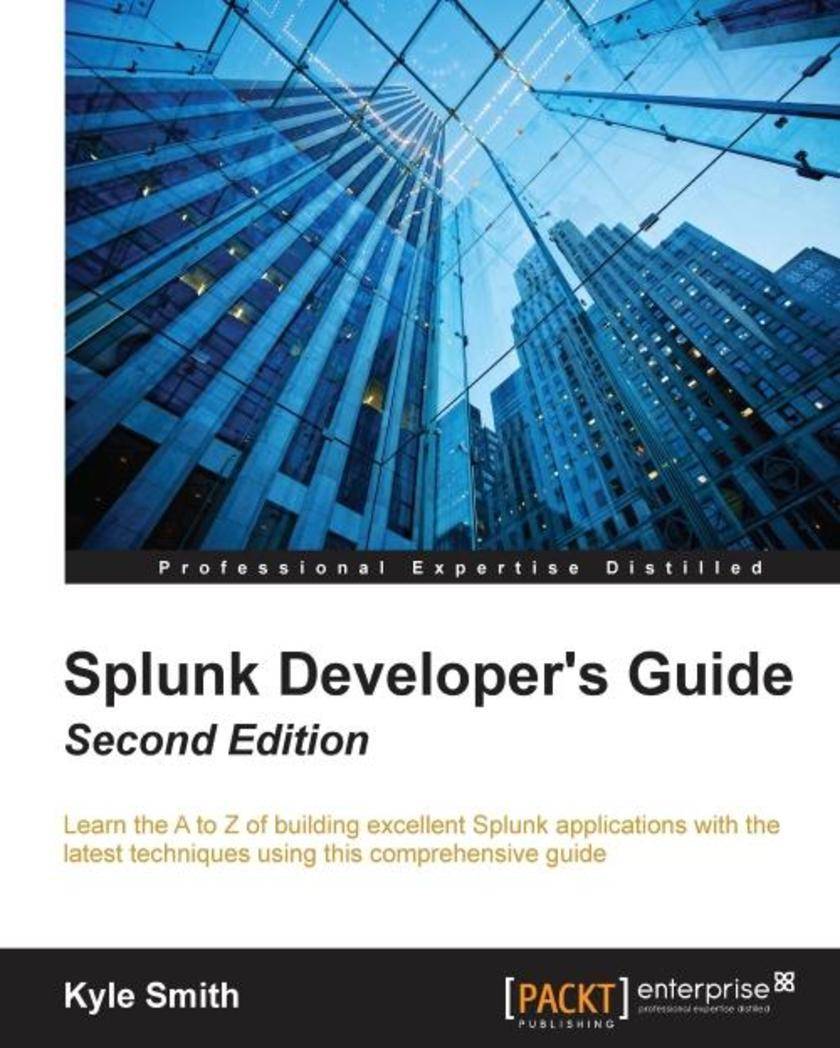
Splunk Developer's Guide - Second Edition
¥80.65
Learn the A to Z of building excellent Splunk applications with the latest techniques using this comprehensive guideAbout This BookThis is the most up-to-date book on Splunk 6.3 for developersGet ahead of being just a Splunk user and start creating custom Splunk applications as per your needsYour one-stop-solution to Splunk application developmentWho This Book Is ForThis book is for those who have some familiarity with Splunk and now want to learn how to develop an efficient Splunk application. Previous experience with Splunk, writing searches, and designing basic dashboards is expected.What You Will LearnImplement a Modular Input and a custom D3 data visualizationCreate a directory structure and set view permissionsCreate a search view and a dashboard view using advanced XML modulesEnhance your application using eventtypes, tags, and macrosPackage a Splunk application using best practicesPublish a Splunk application to the Splunk communityIn DetailSplunk provides a platform that allows you to search data stored on a machine, analyze it, and visualize the analyzed data to make informed decisions. The adoption of Splunk in enterprises is huge, and it has a wide range of customers right from Adobe to Dominos. Using the Splunk platform as a user is one thing, but customizing this platform and creating applications specific to your needs takes more than basic knowledge of the platform.This book will dive into developing Splunk applications that cater to your needs of making sense of data and will let you visualize this data with the help of stunning dashboards.This book includes everything on developing a full-fledged Splunk application right from designing to implementing to publishing. We will design the fundamentals to build a Splunk application and then move on to creating one. During the course of the book, we will cover application data, objects, permissions, and more. After this, we will show you how to enhance the application, including branding, workflows, and enriched data. Views, dashboards, and web frameworks are also covered.This book will showcase everything new in the latest version of Splunk including the latest data models, alert actions, XML forms, various dashboard enhancements, and visualization options (with D3). Finally, we take a look at the latest Splunk cloud applications, advanced integrations, and development as per the latest release.Style and approachThis book is an easy-to-follow guide with lots of tips and tricks to help you master all the concepts necessary to develop and deploy your Splunk applications.

JavaScript Projects for Kids
¥45.77
Gear up for a roller-coaster ride into the world of JavaScript and programming with this easy-to-follow, fun, and entertaining project-based guideAbout This BookGet to know the concepts of HTML and CSS to work with JavaScriptExplore the concepts of object-oriented programmingFollow this step-by-step guide on the fundamentals of JavaScript programmingWho This Book Is ForIf you've never written code before or you are completely new to the world of web programming, then this book is the right choice for you. This book is for kids of age 10 years and above and parents who are completely new to the world of programming and want to get introduced to programming.What You Will LearnLearn how to work with Google Developer tools to iterate, debug and profile your codeDevelop a Battleship game using the basic concepts of HTML and CSSGet to know the fundamentals of JavaScript programmingCreate our own version of Pac Man game.Discover the vital concepts of object-oriented programmingIn DetailJavaScript is the most widely-used programming language for web development and that's not all! It has evolved over the years and is now being implemented in an array of environments from websites to robotics. Learning JavaScript will help you see the broader picture of web development.This book will take your imagination to new heights by teaching you how to work with JavaScript from scratch. It will introduce you to HTML and CSS to enhance the appearance of your applications. You’ll then use your skills to build on a cool Battleship game! From there, the book will introduce you to jQuery and show you how you can manipulate the DOM. You’ll get to play with some cool stuff using Canvas and will learn how to make use of Canvas to build a game on the lines of Pacman, only a whole lot cooler! Finally, it will show you a few tricks with OOP to make your code clean and will end with a few road maps on areas you can explore further.Style and approachThis is an easy-to-follow, informative, and fun guide that takes a project-based approach to teaching programming in JavaScript. You will learn everything you need to get started with serious web application development.
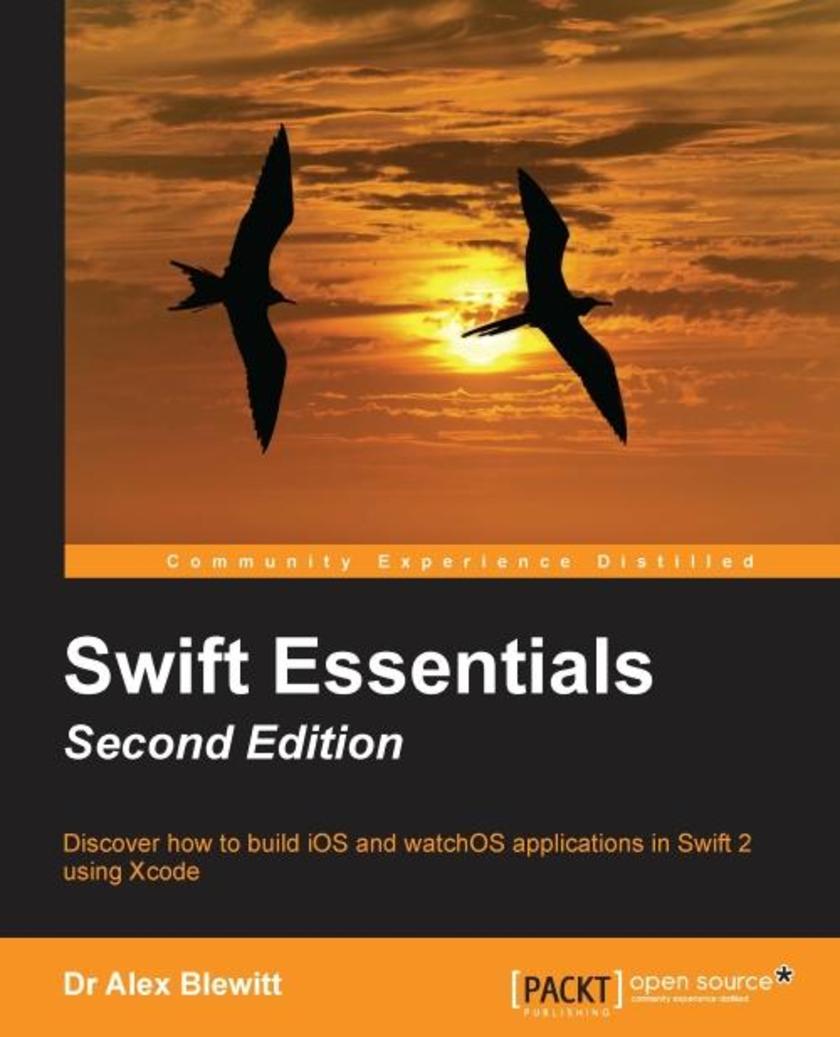
Swift Essentials - Second Edition
¥63.21
Discover how to build iOS and watchOS applications in Swift 2 using XcodeAbout This BookGets you up and running with Swift programming without any prior iOS development experience.A fast paced guide showing best practices and lets you get up to speed with Swift to quickly build your own iOS applicationsA unique practical approach to make your life with Swift easy.Who This Book Is ForAre you interested in learning SwiftDo you want to write iOS applications in SwiftIf yes, then this is the book for you. No prior iOS programming experience is assumed; however, having some experience with any programming language will be beneficial.What You Will LearnDive into Swift and explore its innovative and powerful syntaxWork with Swift in Xcode to get a unique and productive approach to developmentFind out how to create complete iOS applicationsDiscover rapid prototyping with a Swift playgroundGet to know how to use the Swift storyboard to develop multi-page applicationsGet to grips with parsing JSON and XML data from network sourcesBuild a network client for GitHub repositories, with full source code on GitHubIn DetailSwift was considered one of the biggest innovations last year, and certainly with Swift 2 announced at WWDC in 2015, this segment of the developer space will continue to be hot and dominating.This is a fast-paced guide to provide an overview of Swift programming and then walks you through in detail how to write iOS applications. Progress through chapters on custom views, networking, parsing and build a complete application as a Git repository, all by using Swift as the core languageStyle and approachThis fast-paced practical guide will quickly give you hands-on experience with all the features of Swift programming. Following the practical examples in the book will help you successfully create your own iOS applications.
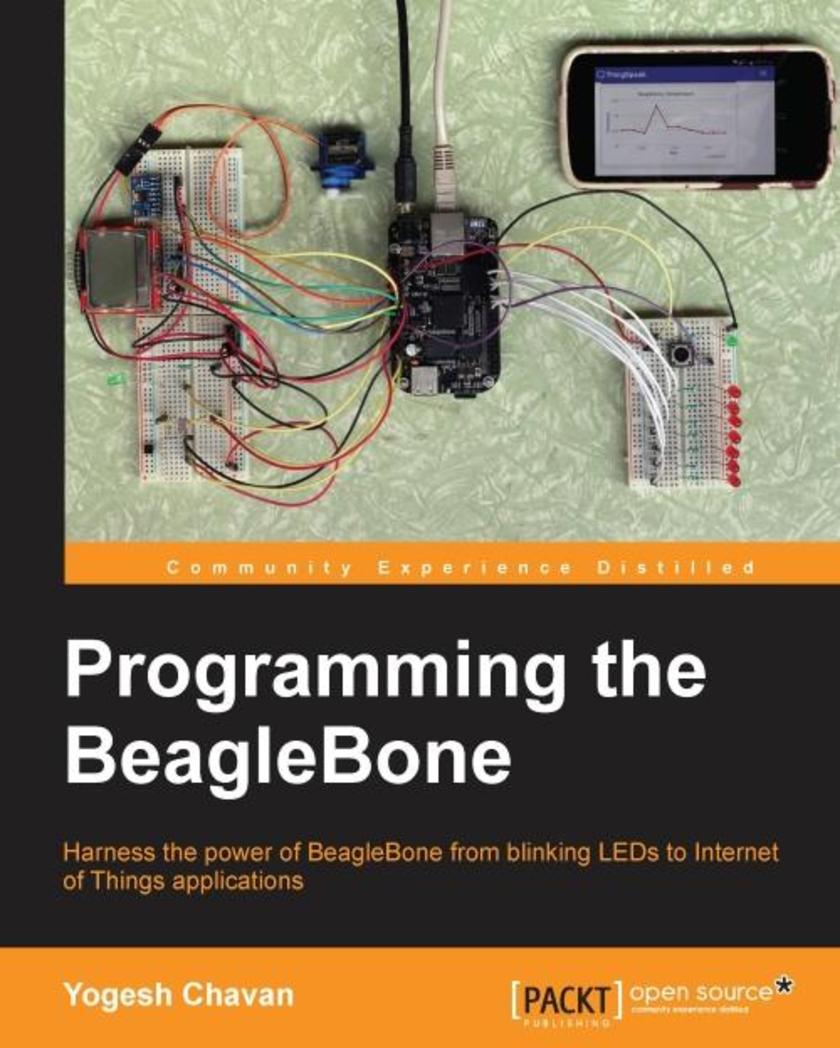
Programming the BeagleBone
¥54.49
Master BeagleBone programming by doing simple electronics and Internet of Things projectsAbout This BookQuickly develop electronics projects that interact with Internet applications using JavaScript and PythonLearn about electronics components such as sensors and motors, and how to communicate with them by writing programsA step-by-step guide to explore the exciting world of BeagleBone—from connecting BeagleBone to doing electronics projects and creating IoT applicationsWho This Book Is ForIf you want to learn programming on embedded systems with BeagleBone by doing simple electronics projects, this book is for you. This book is also helpful to BeagleBone owners who want to quickly implement small-scale home automation solutions. It is assumed that you have familiarity with C and Python programming. Some familiarity with electronics is helpful but not essential.What You Will LearnConnect your BeagleBone to a computer in different ways and get the Cloud9 IDE running to quick-start programming on the BeagleBoneGet to know about BeagleBone extension pins such as GPIO and how to connect various electronics components with BeagleBoneRead and write to various electronics components such as LED, Push-button, sensors, and motorsGrasp in-depth theory on Analog, PWM, and BUS programming and the electronics components used in programsHandle data to and from various BUS supporting modules such as UART, I2C, and SPI using the Adafruit BBIO Python libraryWrite real-life IoT applications in JavaScript and Python such as shooting an e-mail on overheat and controlling a servo motor remotelyMake use of online free cloud services to store and analyze sensor data collected on the BeagleBoneDiscover what else can be done using the BeagleBoneGet to grips with embedded system BUS communicationIn DetailThe whole world is moving from desktop computers to smartphones and embedded systems. We are moving towards utilizing Internet of Things (IoT). An exponential rise in the demand for embedded systems and programming in the last few years is driving programmers to use embedded development boards such as Beaglebone.BeagleBone is an ultra-small, cost-effective computer that comes with a powerful hardware. It runs a full-fledged Debian Linux OS and provides numerous electronics solutions. BeagleBone is open source and comes with an Ethernet port, which allows you to deploy IoT projects without any additions to the board. It provides plenty of GPIO, Anlaog pins, and UART, I2C, SPI pins which makes it the right choice to perform electronics projects. This gives you all the benefits of Linux kernel such as multitasking, multiusers, and extensive device driver support. This allows you to do programming in many languages including high-level languages such as JavaScript and Python.This book aims to exploit the hardware and software capabilities of BeagleBone to create real-life electronics and IoT applications quickly. It is divided into two parts. The first part covers JavaScript programs. The second part provides electronics projects and IoT applications in Python.First, you will learn to use BeagleBone as tool to write useful applications on embedded systems. Starting with the basics needed to set up BeagleBone and the Cloud9 IDE, this book covers interfacing with various electronics components via simple programs. The electronics theory related to these components is then explained in depth before you use them in a program. Finally, the book helps you create some real-life IoT applications.Style and approachAn easy-to-follow guide full of real-world electronics programs and quick troubleshooting tips using BeagleBone. All the required electronics concepts are explained in detail before using them in a program and all programs are explained in depth. Most of the theory is covered in the first part; while the second part gives you some quick programs.
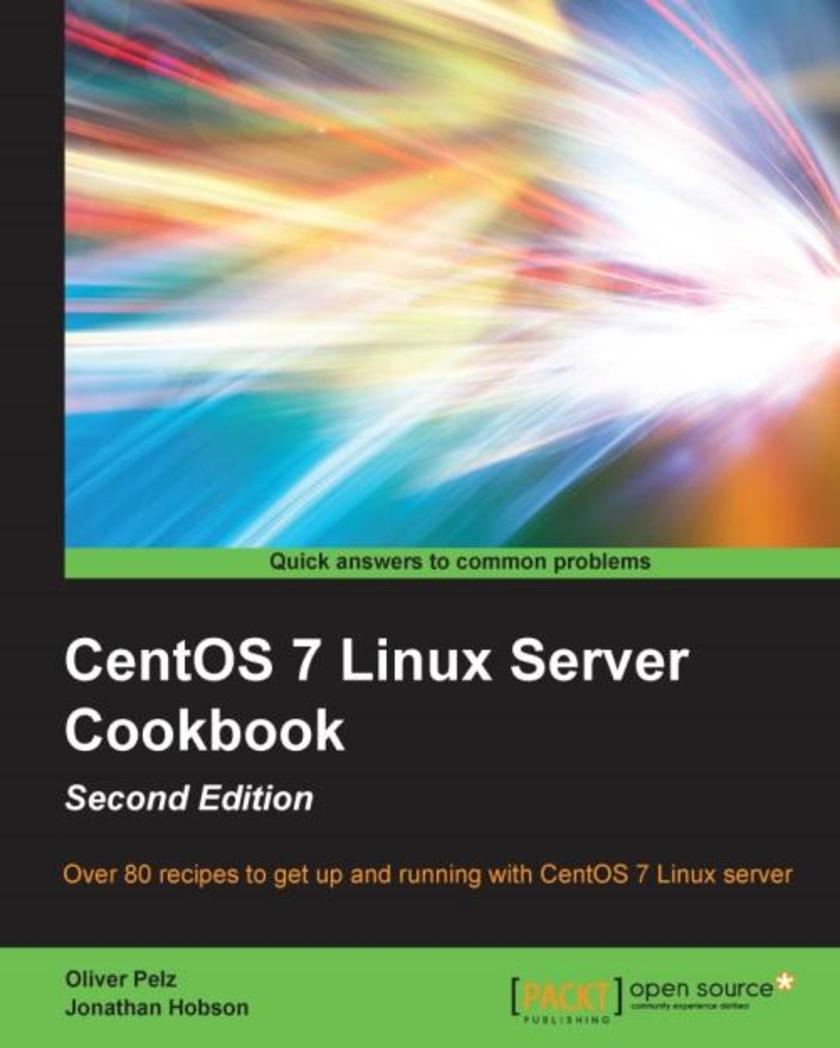
CentOS 7 Linux Server Cookbook - Second Edition
¥90.46
Over 80 recipes to get up and running with CentOS 7 Linux serverAbout This BookA practical guide to install, configure, administer and maintain CentOS 7 serversAn in-depth guide to the CentOS 7 operating system, exploring its various new features and changes in server administrationPresents tricks and solutions to tackle common server issues with the help of practical examples and real-life scenariosWho This Book Is ForThis book is targeted at beginner and more experienced system administrators alike who want to use CentOS as their server solution. Readers do not need much pre-knowledge or experience at all to work with this book.What You Will LearnInstall and configure CentOS 7 Linux server system from scratch using normal and advanced methodsMaintain a performance-based and secure server solution by deploying expert configuration advice and managing software packagesMonitor, manage and develop your server's file system to maintain a stable performanceGain best practice methods on sharing files and resources through a networkInstall and configure common standard services such as web, mail, FTP, database and domain name server technologiesIntroduce you to the world of operating-system-level virtualization using the Docker platform.Understand the fundamentals of the Security-Enhanced Linux access control architectureMonitor your IT infrastructure using NagiosIn DetailThis book will provide you with a comprehensive series of starting points that will give you direct access to the inner workings of the latest CentOS version 7 and help you trim the learning curve to master your server.You will begin with the installation and basic configuration of CentOS 7, followed by learning how to manage your system, services and software packages. You will then gain an understanding of how to administer the file system, secure access to your server and configure various resource sharing services such as file, printer and DHCP servers across your network. Further on, we cover advanced topics such as FTP services, building your own DNS server, running database servers, and providing mail and web services. Finally, you will get a deep understanding of SELinux and you will learn how to work with Docker operating-system virtualization and how to monitor your IT infrastructure with Nagios.By the end of this book, you will have a fair understanding of all the aspects of configuring, implementing and administering CentOS 7 Linux server and how to put it in control.Style and approachThis book is a practical reference guide with hands-on examples and solutions to real-world administration problems. It covers in-depth and comprehensive information on CentOS 7 and its new features.
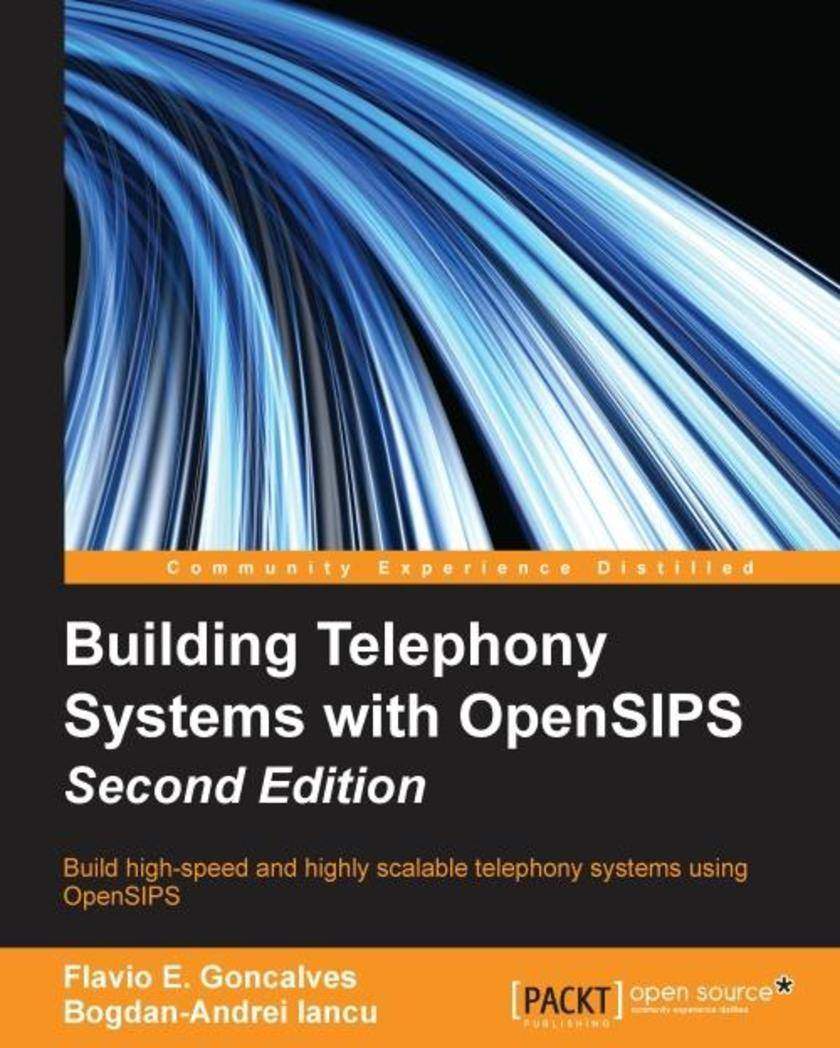
Building Telephony Systems with OpenSIPS - Second Edition
¥80.65
Build high-speed and highly scalable telephony systems using OpenSIPSAbout This BookInstall and configure OpenSIPS to authenticate, route, bill, and monitor VoIP callsGain a competitive edge using the most scalable VoIP technologyDiscover the latest features of OpenSIPS with practical examples and case studiesWho This Book Is ForIf you want to understand how to build a SIP provider from scratch using OpenSIPS, then this book is ideal for you. It is beneficial for VoIP providers, large enterprises, and universities. This book will also help readers who were using OpenSER but are now confused with the new OpenSIPS.Telephony and Linux experience will be helpful to get the most out of this book but is not essential. Prior knowledge of OpenSIPS is not assumed.What You Will LearnLearn to prepare and configure a Linux system for OpenSIPSFamiliarise yourself with the installation and configuration of OpenSIPSUnderstand how to set a domain and create users/extensionsConfigure SIP endpoints and make calls between themMake calls to and from the PSTN and create access control lists to authorize callsInstall a graphical user interface to simplify the task of provisioning user and system informationImplement an effective billing system with OpenSIPSMonitor and troubleshoot OpenSIPS to keep it running smoothlyIn DetailOpenSIPS is a multifunctional, multipurpose signalling SIP server. SIP (Session Initiation Protocol) is nowadays the most important VoIP protocol and OpenSIPS is the open source leader in VoIP platforms based on SIP. OpenSIPS is used to set up SIP Proxy servers. The purpose of these servers is to receive, examine, and classify SIP requests. The whole telecommunication industry is changing to an IP environment, and telephony as we know it today will completely change in less than ten years. SIP is the protocol leading this disruptive revolution and it is one of the main protocols on next generation networks. While a VoIP provider is not the only kind of SIP infrastructure created using OpenSIPS, it is certainly one of the most difficult to implement.This book will give you a competitive edge by helping you to create a SIP infrastructure capable of handling tens of thousands of subscribers.Starting with an introduction to SIP and OpenSIPS, you will begin by installing and configuring OpenSIPS. You will be introduced to OpenSIPS Scripting language and OpenSIPS Routing concepts, followed by comprehensive coverage of Subscriber Management. Next, you will learn to install, configure, and customize the OpenSIPS control panel and explore dialplans and routing. You will discover how to manage the dialog module, accounting, NATTraversal, and other new SIP services. The final chapters of the book are dedicated to troubleshooting tools, SIP security, and advanced scenarios including TCP/TLS support, load balancing, asynchronous processing, and more.A fictional VoIP provider is used to explain OpenSIPS and by the end of the book, you will have a simple but complete system to run a VoIP provider.Style and approachThis book is a step-by-step guide based on the example of a VoIP provider. You will start with OpenSIPS installation and gradually, your knowledge depth will increase.
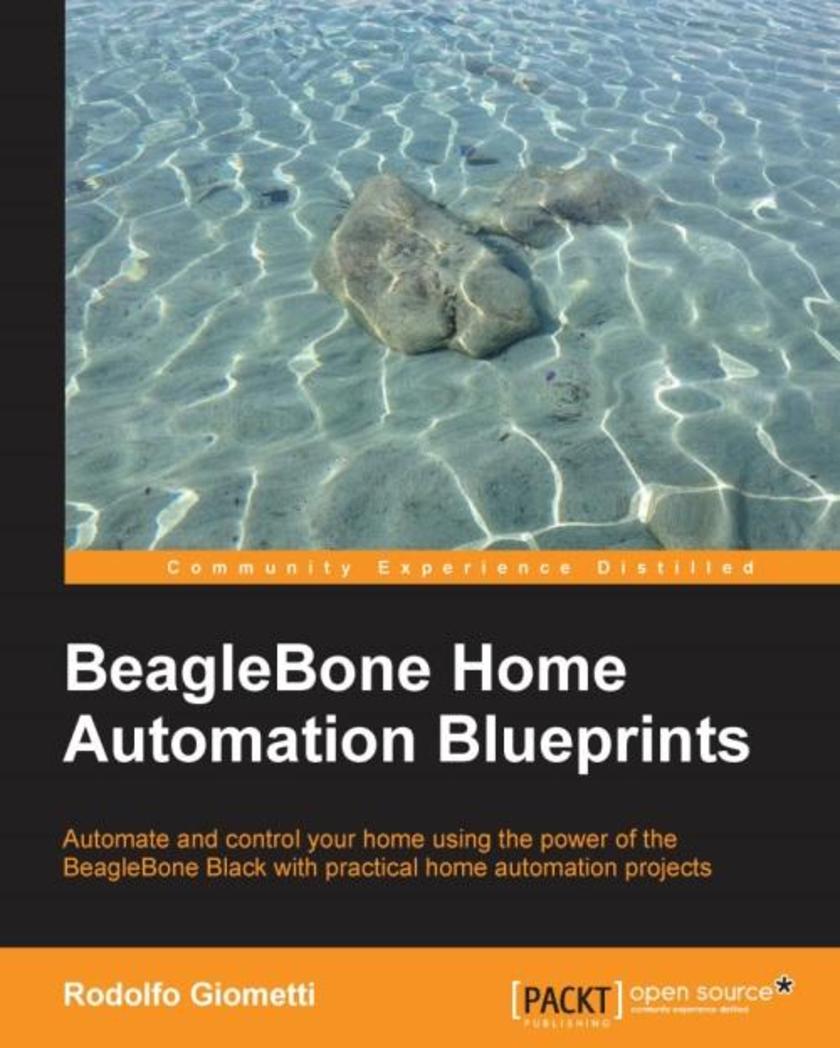
BeagleBone Home Automation Blueprints
¥80.65
Automate and control your home using the power of the BeagleBone Black with practical home automation projectsAbout This BookBuild, set up, and develop your circuits via step-by-step tutorial of practical examples, from initial board setup to device driver managementGet access to several kinds of computer peripherals to monitor and control your domestic environment using this guideThis book is spread across 10 chapters all focused on one practical home automation projectWho This Book Is ForThis book is for developers who know how to use BeagleBone and are just above the “beginner” level. If you want to learn to use embedded machine learning capabilities, you should have some experience of creating simple home automation projects.What You Will LearnBuild a CO (and other gas) sensor with a buzzer/LED alarm to signal high concentrationsLog environment data and plot it in a fancy mannerDevelop a simple web interface with a LAMP platformPrepare complex web interfaces in JavaScript and get to know how to stream video data from a webcamUse APIs to get access to a Google Docs account or a WhatsApp/Facebook account to manage a home automation systemAdd custom device drivers to manage an LED with different blinking frequenciesDiscover how to work with electronic components to build small circuitsUse an NFS, temperature sensor, relays, and other peripherals to monitor and control your surroundingsIn DetailBeagleBone is a microboard PC that runs Linux. It can connect to the Internet and can run OSes such as Android and Ubuntu. BeagleBone is used for a variety of different purposes and projects, from simple projects such as building a thermostat to more advanced ones such as home security systems.Packed with real-world examples, this book will provide you with examples of how to connect several sensors and an actuator to the BeagleBone Black. You’ll learn how to give access to them, in order to realize simple-to-complex monitoring and controlling systems that will help you take control of the house. You will also find software examples of implementing web interfaces using the classical PHP/HTML pair with JavaScript, using complex APIs to interact with a Google Docs account, WhatsApp, or Facebook. This guide is an invaluable tutorial if you are planning to use a BeagleBone Black in a home automation project.Style and approachThis step-by-step guide contains several home automation examples that can be used as base projects for tons of other home automation and control systems. Through clear, concise examples based on real-life situations, you will quickly get to grips with the core concepts needed to develop home automation applications with the BeagleBone Black using both the C language and high-level *ing languages such as PHP, Python, and JavaScript.
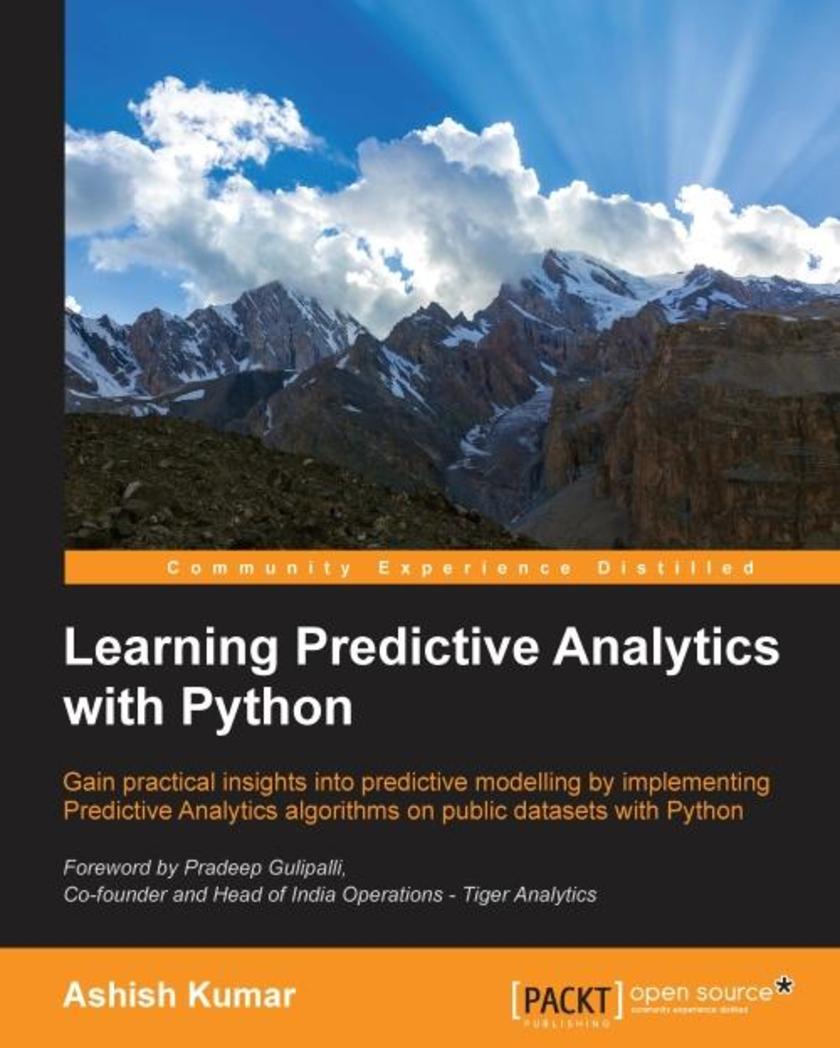
Learning Predictive Analytics with Python
¥90.46
Gain practical insights into predictive modelling by implementing Predictive Analytics algorithms on public datasets with PythonAbout This BookA step-by-step guide to predictive modeling including lots of tips, tricks, and best practicesGet to grips with the basics of Predictive Analytics with PythonLearn how to use the popular predictive modeling algorithms such as Linear Regression, Decision Trees, Logistic Regression, and ClusteringWho This Book Is ForIf you wish to learn how to implement Predictive Analytics algorithms using Python libraries, then this is the book for you. If you are familiar with coding in Python (or some other programming/statistical/*ing language) but have never used or read about Predictive Analytics algorithms, this book will also help you. The book will be beneficial to and can be read by any Data Science enthusiasts. Some familiarity with Python will be useful to get the most out of this book, but it is certainly not a prerequisite.What You Will LearnUnderstand the statistical and mathematical concepts behind Predictive Analytics algorithms and implement Predictive Analytics algorithms using Python librariesAnalyze the result parameters arising from the implementation of Predictive Analytics algorithmsWrite Python modules/functions from scratch to execute segments or the whole of these algorithmsRecognize and mitigate various contingencies and issues related to the implementation of Predictive Analytics algorithmsGet to know various methods of importing, cleaning, sub-setting, merging, joining, concatenating, exploring, grouping, and plotting data with pandas and numpyCreate dummy datasets and simple mathematical simulations using the Python numpy and pandas librariesUnderstand the best practices while handling datasets in Python and creating predictive models out of themIn DetailSocial Media and the Internet of Things have resulted in an avalanche of data. Data is powerful but not in its raw form - It needs to be processed and modeled, and Python is one of the most robust tools out there to do so. It has an array of packages for predictive modeling and a suite of IDEs to choose from. Learning to predict who would win, lose, buy, lie, or die with Python is an indispensable skill set to have in this data age.This book is your guide to getting started with Predictive Analytics using Python. You will see how to process data and make predictive models from it. We balance both statistical and mathematical concepts, and implement them in Python using libraries such as pandas, scikit-learn, and numpy.You’ll start by getting an understanding of the basics of predictive modeling, then you will see how to cleanse your data of impurities and get it ready it for predictive modeling. You will also learn more about the best predictive modeling algorithms such as Linear Regression, Decision Trees, and Logistic Regression. Finally, you will see the best practices in predictive modeling, as well as the different applications of predictive modeling in the modern world.Style and approachAll the concepts in this book been explained and illustrated using a dataset, and in a step-by-step manner. The Python code snippet to implement a method or concept is followed by the output, such as charts, dataset heads, pictures, and so on. The statistical concepts are explained in detail wherever required.
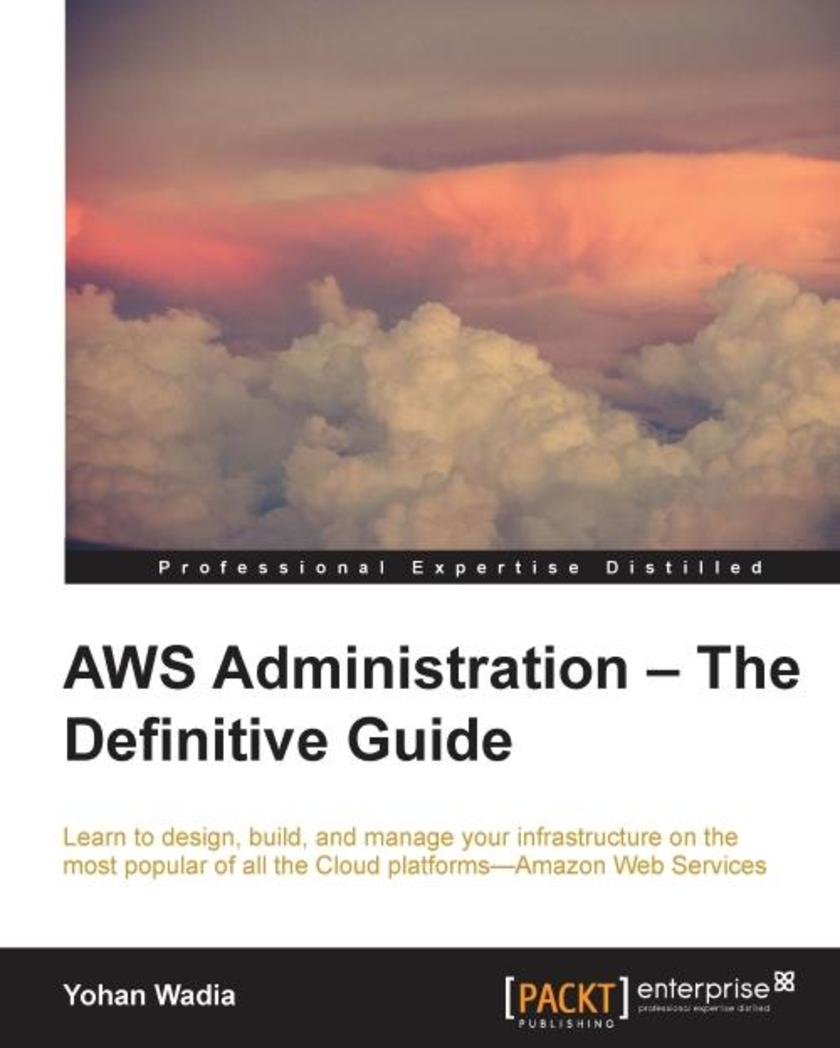
AWS Administration – The Definitive Guide
¥80.65
Learn to design, build, and manage your infrastructure on the most popular of all the Cloud platforms—Amazon Web ServicesAbout This BookLearn how to leverage various Amazon Web Services (AWS) components and services to build a secure, reliable, and robust environment to host your applications onDeep dive into the core AWS service offerings with hands-on tutorials, real-world use case scenarios, and best practicesA self-paced, systematic, and step-by-step guide to learning and implementing AWS in your own environmentWho This Book Is ForThis book is for those who want to learn and leverage AWS. Although no prior experience with AWS is required, it is recommended that you have some hands-on experienceofLinux, Web Services, and basic networkingWhat You Will LearnA brief introduction to Cloud Computing and AWS accompanied by steps to sign up for your first AWS accountCreate and manage users, groups, and permissions using AWSS Identity and Access Management servicesGet started with deploying and accessing EC2 instances, working with EBS Volumes and SnapshotsCustomize and create your very own Amazon Machine ImageDesign and deploy your instances on a highly secured, network isolated environment using Amazon VPCEffectively monitor your AWS environment using specialized alarms, custom monitoring metrics, and much moreExplore the various benefits of Database-as-a-Service offerings and leverage them using Amazon RDS and Amazon DynamoDBTake an in-depth look at what’s new with AWS, including EC2 Container Service and Elastic File SystemIn DetailAWS is at the forefront of Cloud Computing today. Many businesses are moving away from traditional datacenters and toward AWS because of its reliability, vast service offerings, lower costs, and high rate of innovation. Because of its versatility and flexible design, AWS can be used to accomplish a variety of simple and complicated tasks such as hosting multitier websites, running large scale parallel processing, content delivery, petabyte storage and archival, and lots more.Whether you are a seasoned sysadmin or a rookie, this book will provide you with all the necessary skills to design, deploy, and manage your applications on the AWS cloud platform. The book guides you through the core AWS services such as IAM, EC2, VPC, RDS, and S3 using a simple real world application hosting example that you can relate to. Each chapter is designed to provide you with the most information possible about a particular AWS service coupled with easy to follow hands-on steps, best practices, tips, and recommendations.By the end of the book, you will be able to create a highly secure, fault tolerant, and scalable environment for your applications to run on.Style and approach This in-depth and insightful guide is filled with easy-to-follow examples, real-world use cases, best practices, and recommendations that will help you design and leverage AWS.
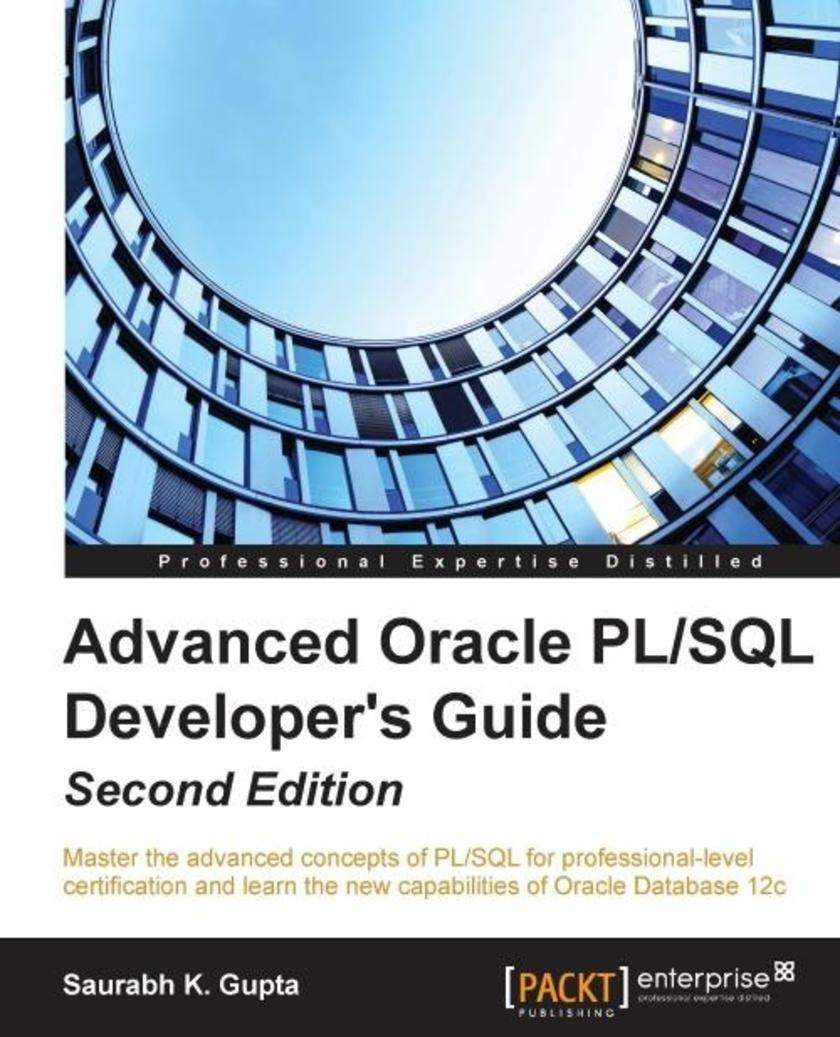
Advanced Oracle PL/SQL Developer's Guide - Second Edition
¥107.90
Master the advanced concepts of PL/SQL for professional-level certification and learn the new capabilities of Oracle Database 12cAbout This BookLearn advanced application development features of Oracle Database 12c and prepare for the 1Z0-146 examinationBuild robust and secure applications in Oracle PL/SQL using the best practicesPacked with feature demonstrations and illustrations that will help you learn and understand the enhanced capabilities of Oracle Database 12cWho This Book Is ForThis book is for Oracle developers responsible for database management. Readers are expected to have basic knowledge of Oracle Database and the fundamentals of PL/SQL programming. Certification aspirants can use this book to prepare for 1Z0-146 examination in order to be an Oracle Certified Professional in Advanced PL/SQL.What You Will LearnLearn and understand the key SQL and PL/SQL features of Oracle Database 12cUnderstand the new Multitenant architecture and Database In-Memory option of Oracle Database 12cKnow more about the advanced concepts of the Oracle PL/SQL language such as external procedures, securing data using Virtual Private Database (VPD), SecureFiles, and PL/SQL code tracing and profilingImplement Virtual Private Databases to prevent unauthorized data accessTrace, analyze, profile, and debug PL/SQL code while developing database applicationsIntegrate the new application development features of Oracle Database 12c with the current conceptsDiscover techniques to analyze and maintain PL/SQL codeGet acquainted with the best practices of writing PL/SQL code and develop secure applicationsIn DetailOracle Database is one of the most popular databases and allows users to make efficient use of their resources and to enhance service levels while reducing the IT costs incurred. Oracle Database is sometimes compared with Microsoft SQL Server, however, Oracle Database clearly supersedes SQL server in terms of high availability and addressing planned and unplanned downtime. Oracle PL/SQL provides a rich platform for application developers to code and build scalable database applications and introduces multiple new features and enhancements to improve development experience.Advanced Oracle PL/SQL Developer's Guide, Second Edition is a handy technical reference for seasoned professionals in the database development space. This book starts with a refresher of fundamental concepts of PL/SQL, such as anonymous block, subprograms, and exceptions, and prepares you for the upcoming advanced concepts. The next chapter introduces you to the new features of Oracle Database 12c, not limited to PL/SQL. In this chapter, you will understand some of the most talked about features such as Multitenant and Database In-Memory. Moving forward, each chapter introduces advanced concepts with the help of demonstrations, and provides you with the latest update from Oracle Database 12c context. This helps you to visualize the pre- and post-applications of a feature over the database releases. By the end of this book, you will have become an expert in PL/SQL programming and will be able to implement advanced concepts of PL/SQL for efficient management of Oracle Database.Style and approach The book follows the structure of the Oracle Certification examination but doesn't restrict itself to the exam objectives. Advanced concepts have been explained in an easy-to-understand style, supported with feature demonstrations and case illustrations.




 购物车
购物车 个人中心
个人中心



